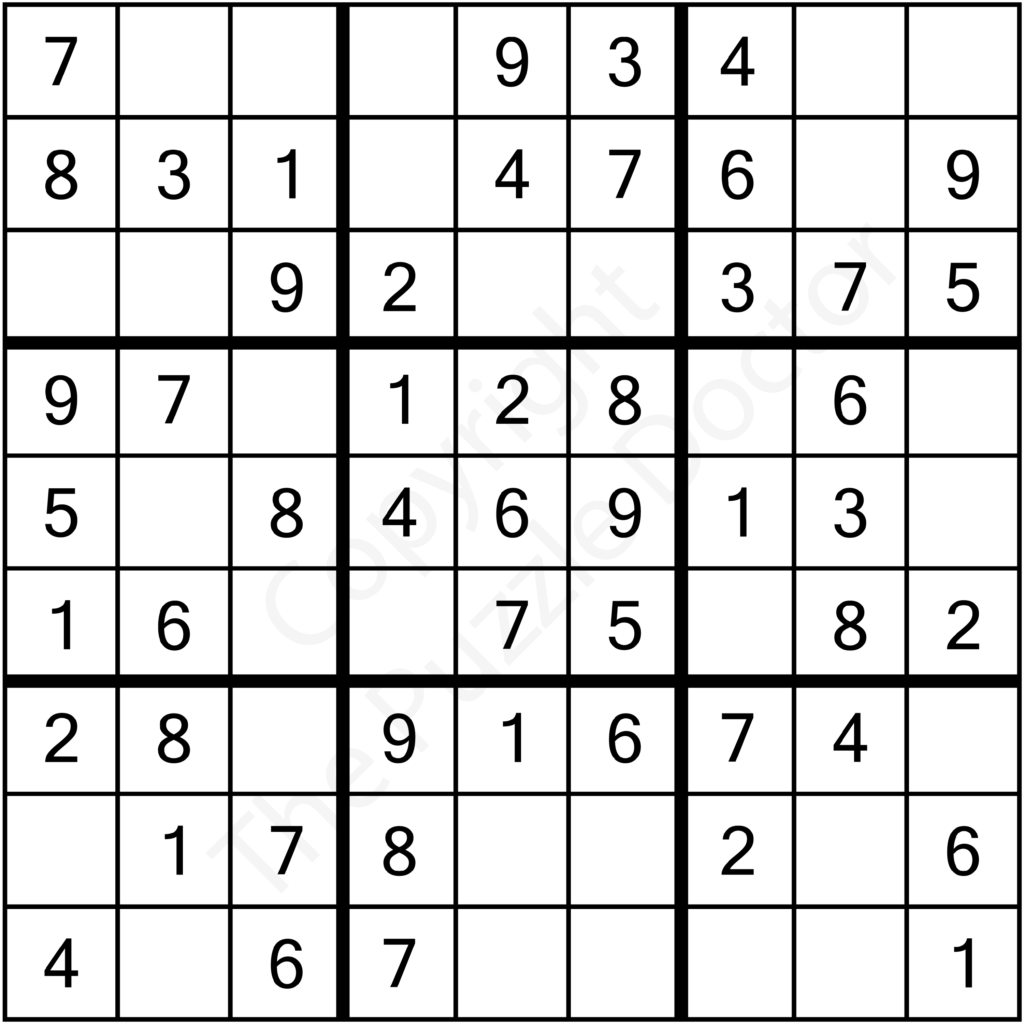Very Easy Sudoku Puzzle Walkthrough
Sometimes although you’ve read the rules and understand the concept, some puzzles can simply be difficult to know where to start. This can be true with Sudoku because the rules are so deceptively simple.
- Each row must contain the digits 1-9, without repetitions
- Each column must contain the digits 1-9, no repetitions
- Each sub-grid must contain the digits 1-9, no repeats in the sub-grid
You even get a grid with some numbers already given. So why can it be so difficult?
Difficulty comes from a variety of sources. While it may seem that the number of givens is why a puzzle is harder or easier, this is not necessarily the case. However, many algorithms that create Sudoku puzzles use the number of givens as a means to categorize the difficulty level of the puzzles. What really contributes to how difficult a Sudoku puzzle may be is a combination of factors including the type of logic decisions to be made, the number of different types of logic desigions, how often they occur, and how complex the logic decisions are.
Very easy puzzles can be solved using simple scanning techniques. Although they can be solved using simple scanning techniques, they are a good way to help you practice looking at rows, columns, and sub-grids, and also a good way to figure out how to use notation if you are new to Sudoku.
In this walkthrough, I take you from the beginning of a very easy puzzle to completion using a simple scanning technique. I also illustrate solving the puzzle using a notation system so you can start to understand how that works. Note that what is illustrated is one approach. There are many different ways to solve the puzzle example. Let’s begin!
The starting grid
When starting a puzzle, there is a Sudoku grid. Scanning the grid, it is obvious there are many givens and we can see that many rows and columns have only two or three cells to fill in.
Start with the obvious, then scan, identify, then eliminate!
Starting from the top, I choose the first row with the fewest missing numbers. It is row B.
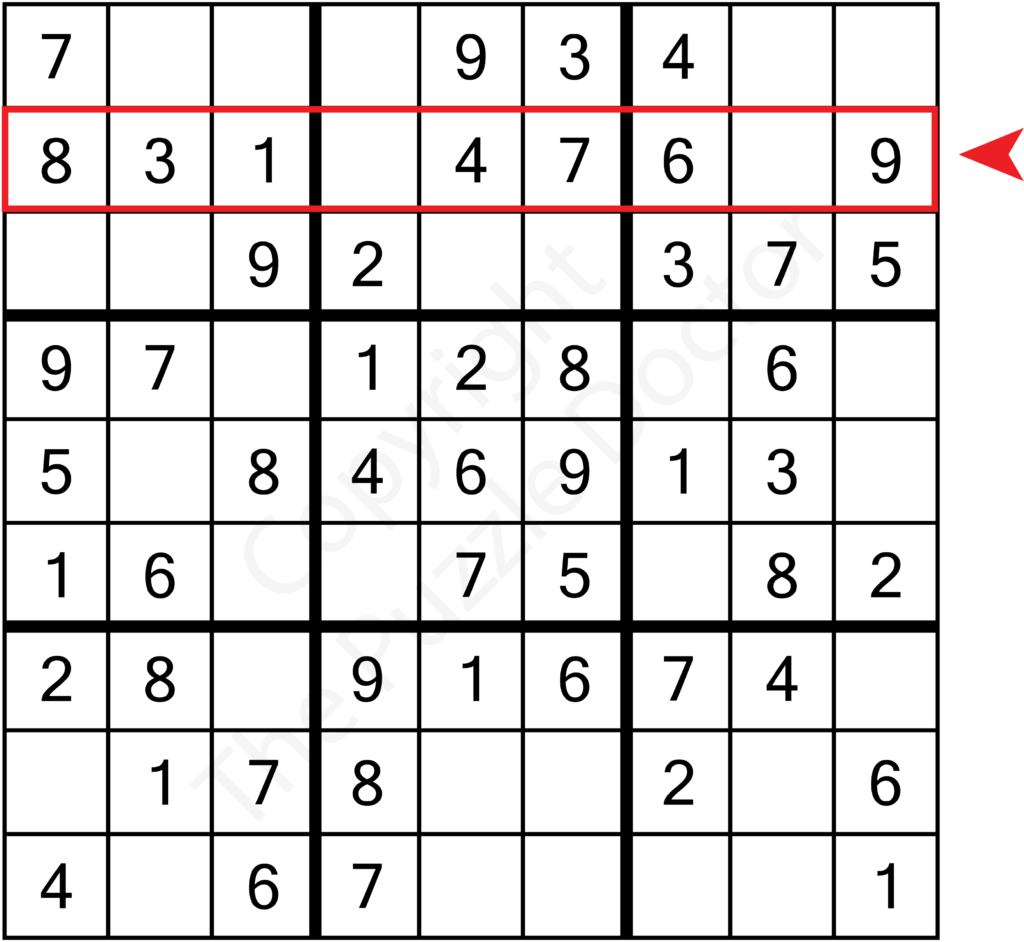
When scanning the row, I determine that 2 and 5 are missing from the row. While in real play I would not necessarily make notations on an easy puzzle, I illustrate using notation so you can see my decisions.
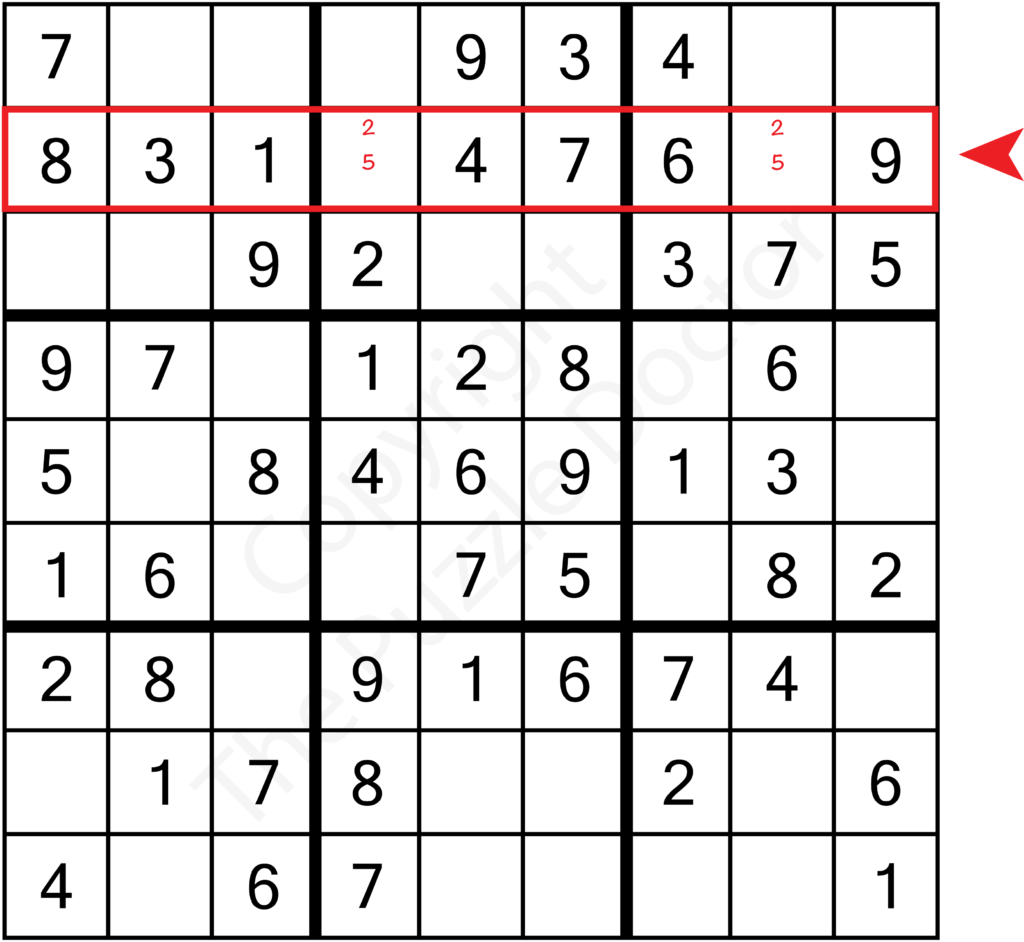
Next, I scan the columns and sub-grids associated with the target cells. In this illustration, sub-grid 2 and 3 are highlighted in red as these are the sub-grids containing the target cells in the row. Columns 4 and 8 are also highlighted as these are the columns containing the target cells.
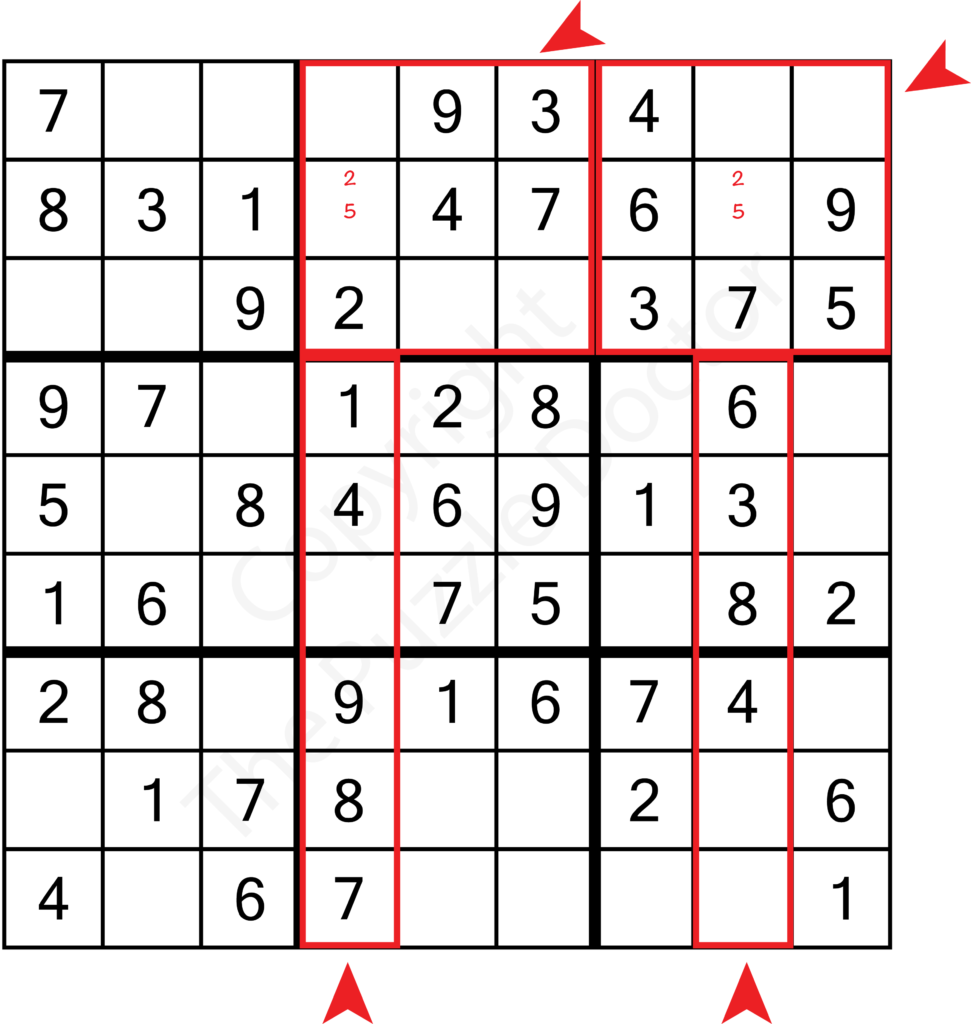
Then, I identify numbers that violate the rules of no repeats in a sub-grid, column, or row and eliminate those numbers from possibilities. In the illustrations below, we see that in column 4, there is a 2 so that number can be eliminated in column 4 row B. In sub-grid 3, we see that the number 5 already exists. We can then eliminate the 5 as a possibility in column 7 row B. These leaves only one candidate for each cell: the number 2 can be placed in column 4 and the number 5 can be placed in column 7.

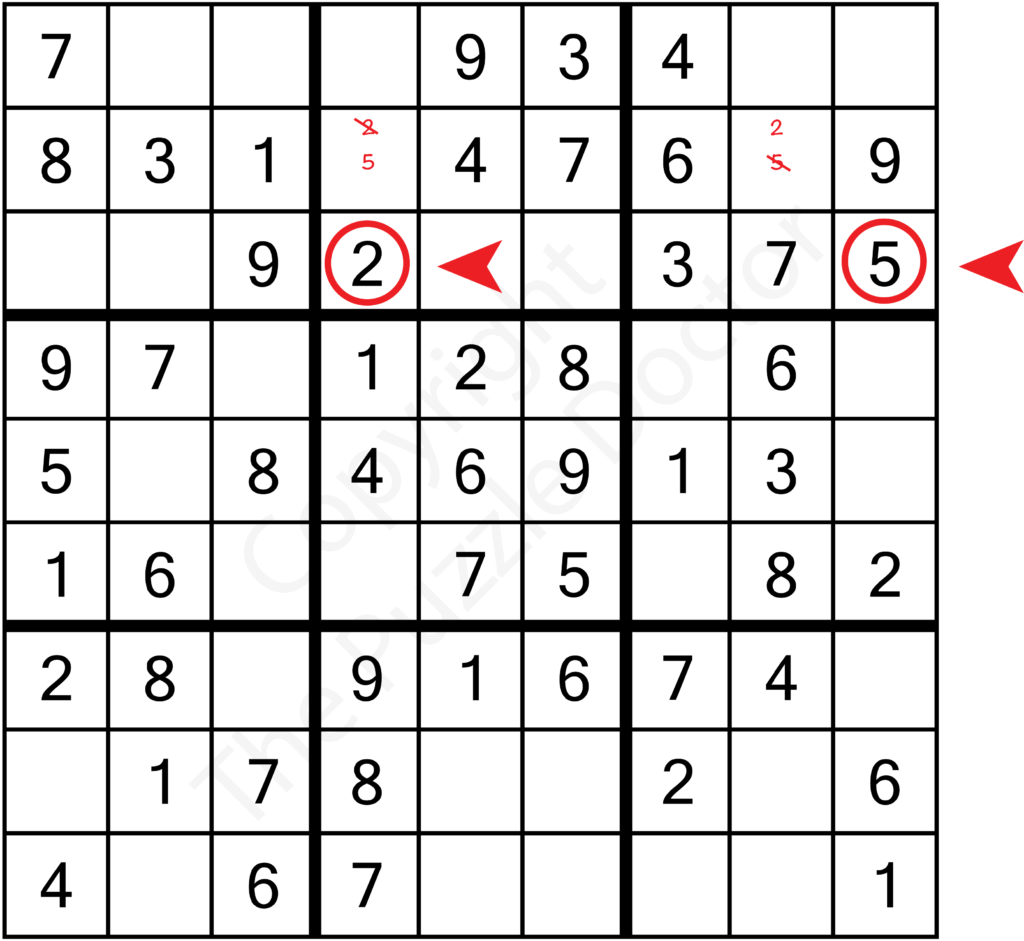
I fill in the numbers and our first row is then completed!
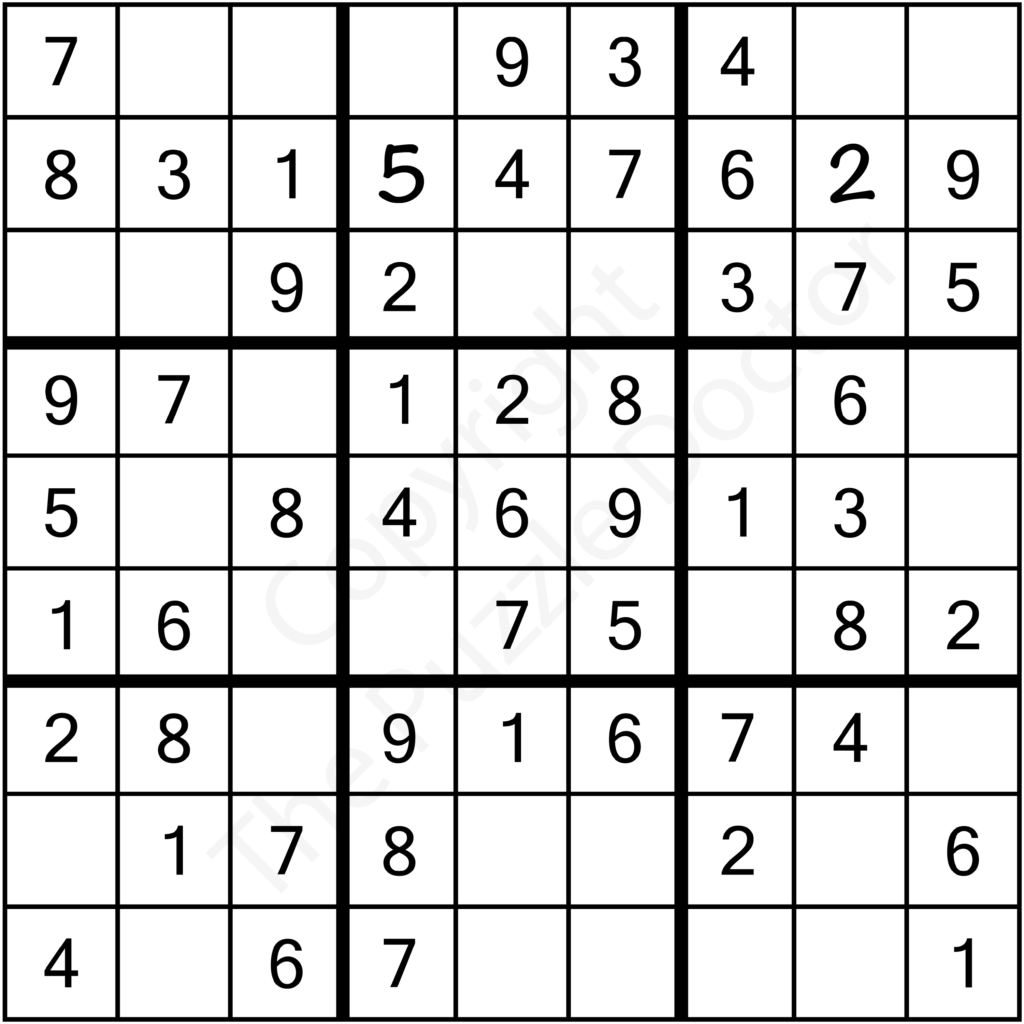
Let’s move on to our next row!
Again we want to start with the obvious, then scan, identify, then eliminate. Here, I’ve scanned for the next row that has the fewest numbers to complete. I identify those numbers as 2 and 7.
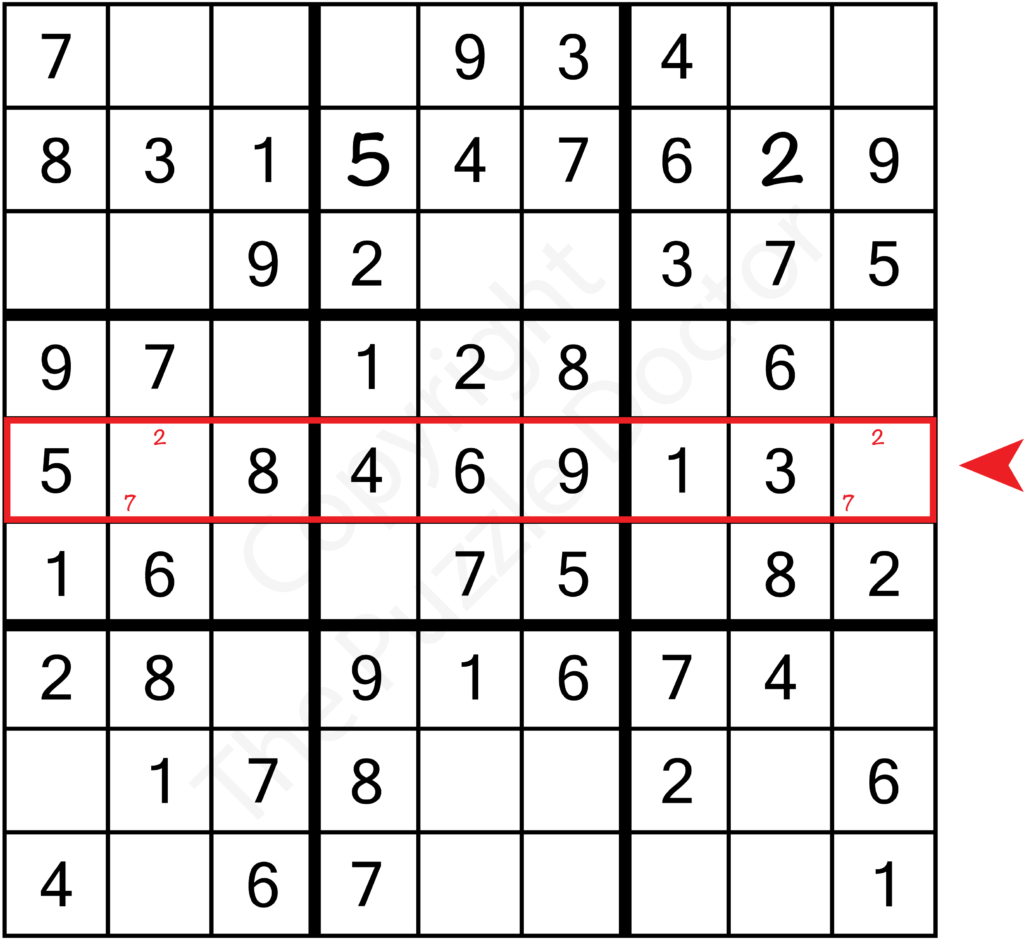
Next, I start scanning the associated columns and sub-grids to identify which numbers would result in a repeat and cannot be placed in the target cells.

That scan results in finding number 7 in sub-grid 4 column 2 which eliminates this as a possible candidate in column 2 of sub-grid 4. I also find that the number 2 is in column 9 row E of sub-grid 6. This prevents the number 2 from being a candidate in column 9 row F of sub-grid 6. Eliminating these as possibilities, I can now fill-in the numbers and complete the row.

Here we are with two rows complete!
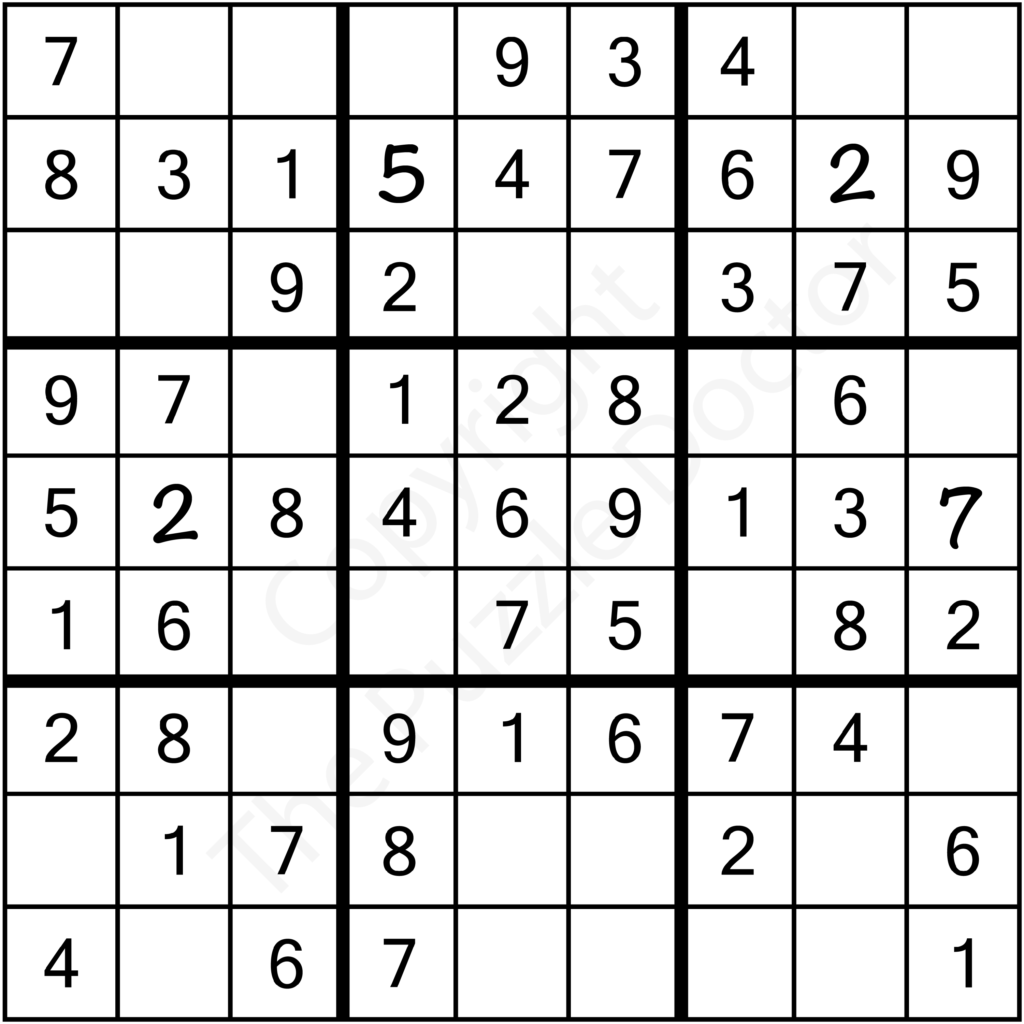
Same scan and eliminate process for the third row
Solving the third row is different because completing one cell in the row depends on completion of the other.
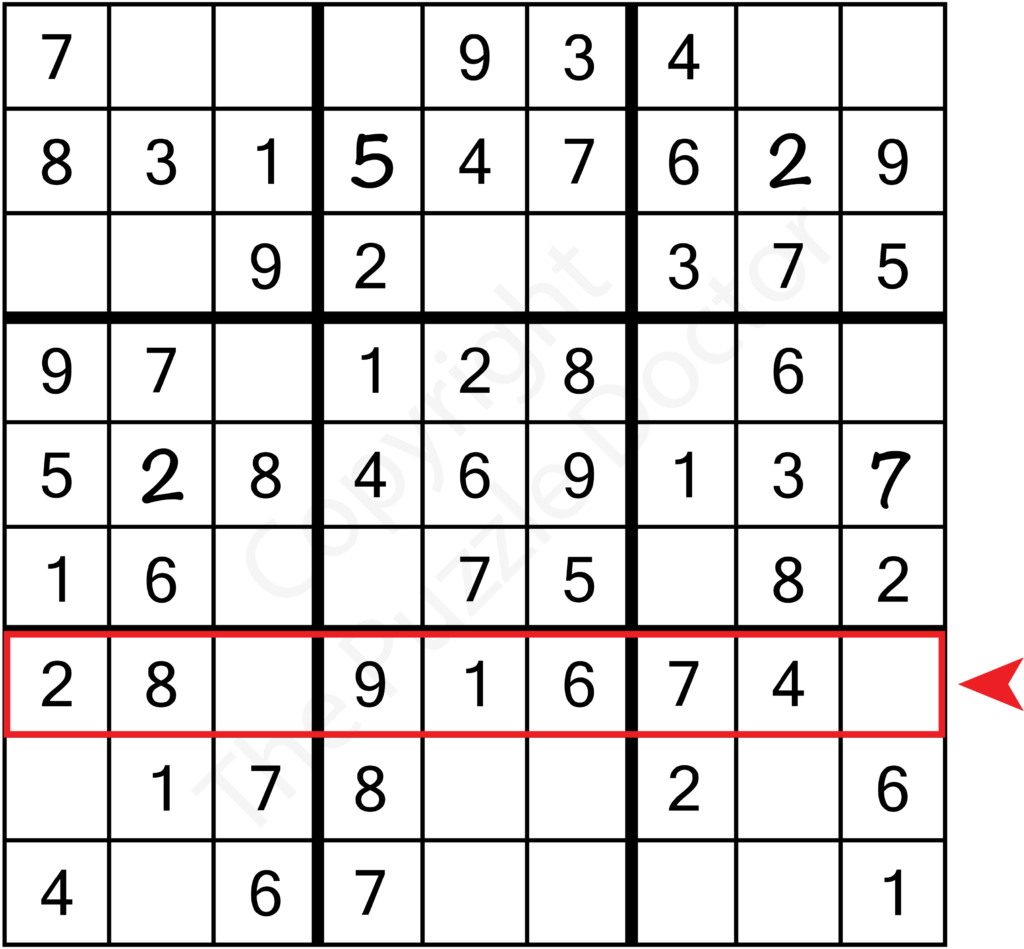
When evaluating row G, I find that the number 3 and 5 are missing. I note this then start scanning the associated columns and sub-grids to see what number can be eliminated. In sub-grid 3 column 9 I find a number 5. This means I can eliminate that number from sub-grid 9 column 9. Not so lucky looking at column 3 or sub-grid 7. However, as the second illustration shows, since we can confidently fill in the number 3 in column 9 of the same row, that leaves us with only one option in column 3. We can now confidently fill in the number 5 in sub-grid 7 column 3, row G.

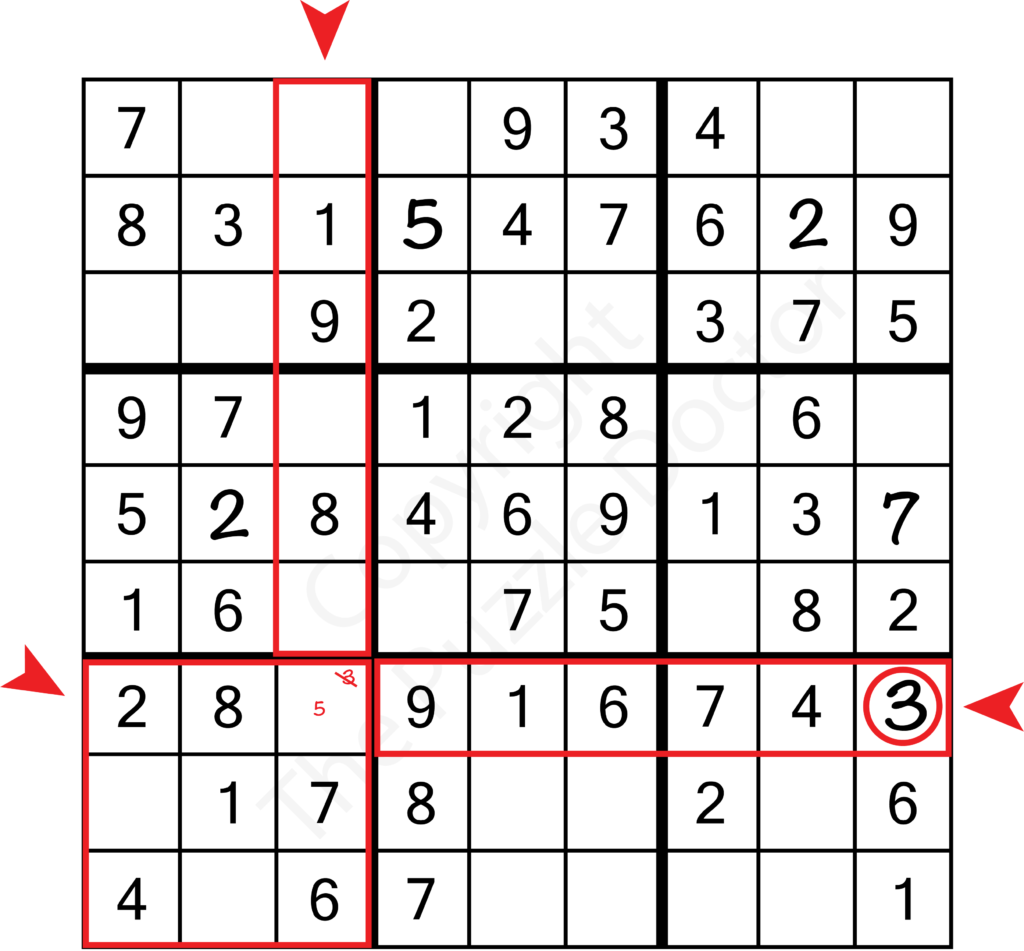
Once again, starting with the obvious, scanning rows, columns, and sub-grids to eliminate candidates makes an easy task of completing our third row.
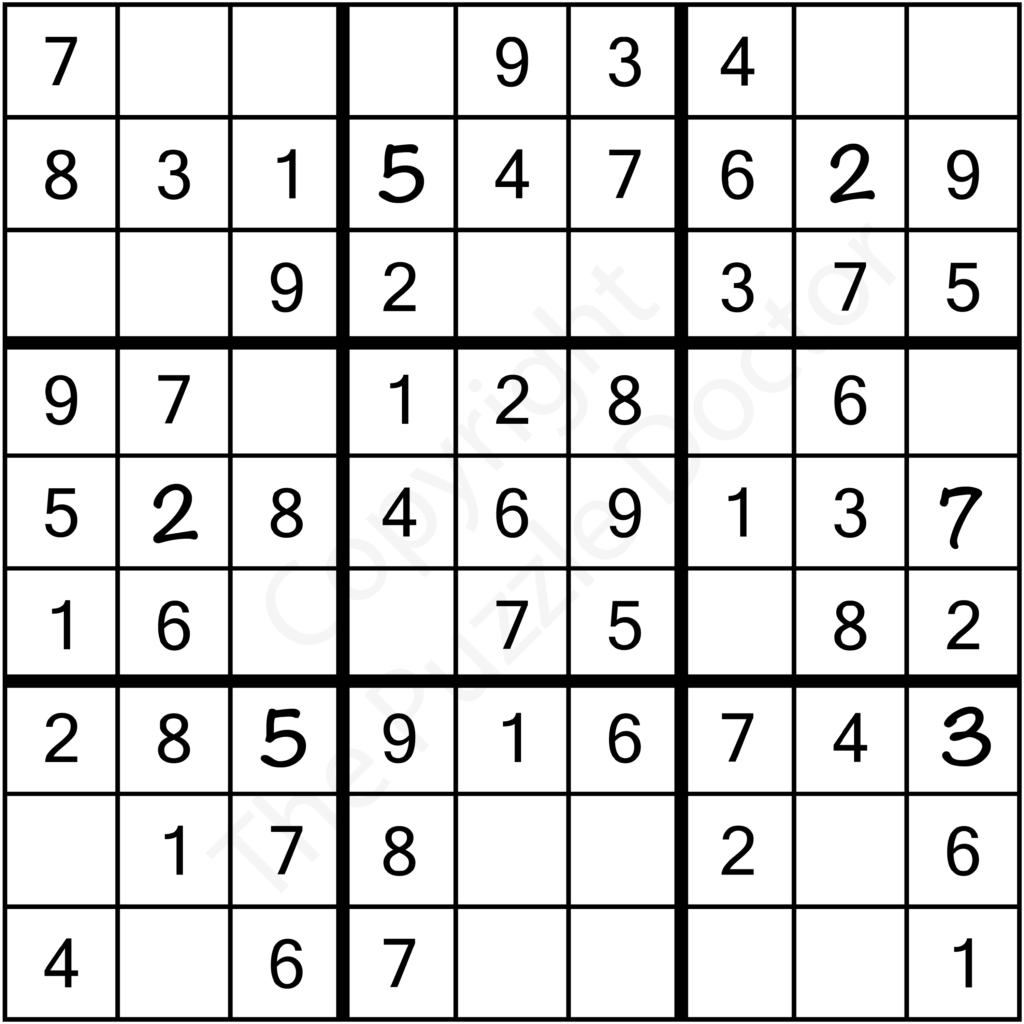
After having completed three rows, the puzzle is really starting to fill out. We now have sub-grid with only one candidate.
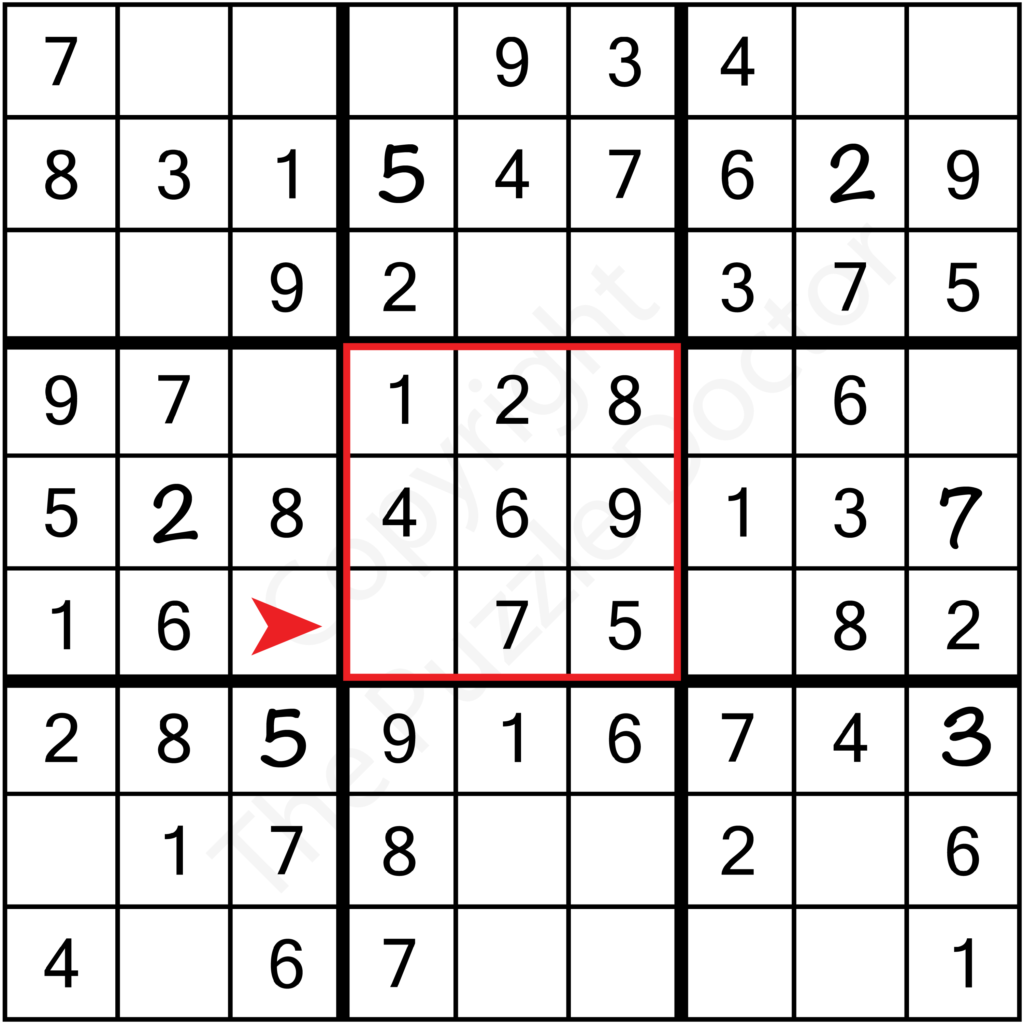
We fill that in and our first sub-grid is complete!

Continue scanning for the obvious
We continue to scan for the obvious and find another obvious choice to fill in
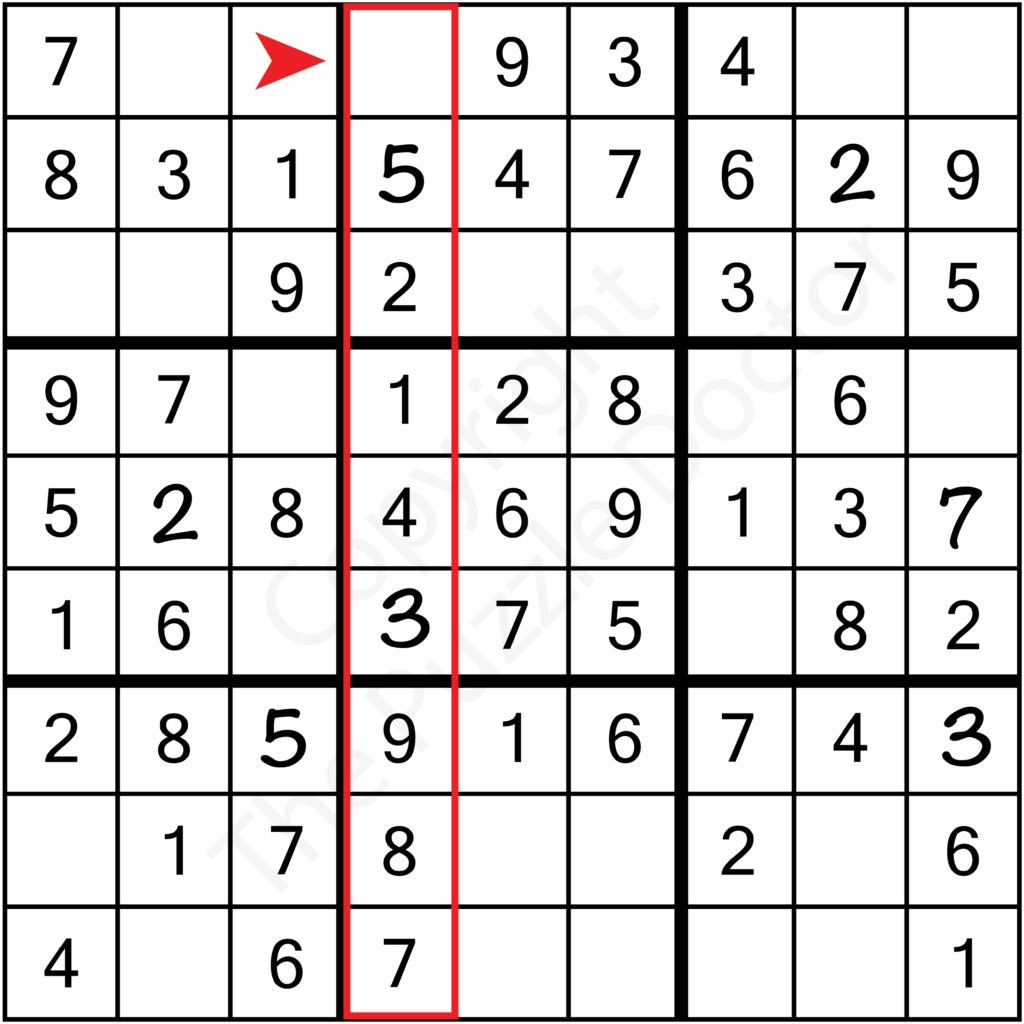
We fill that in and complete our first column!
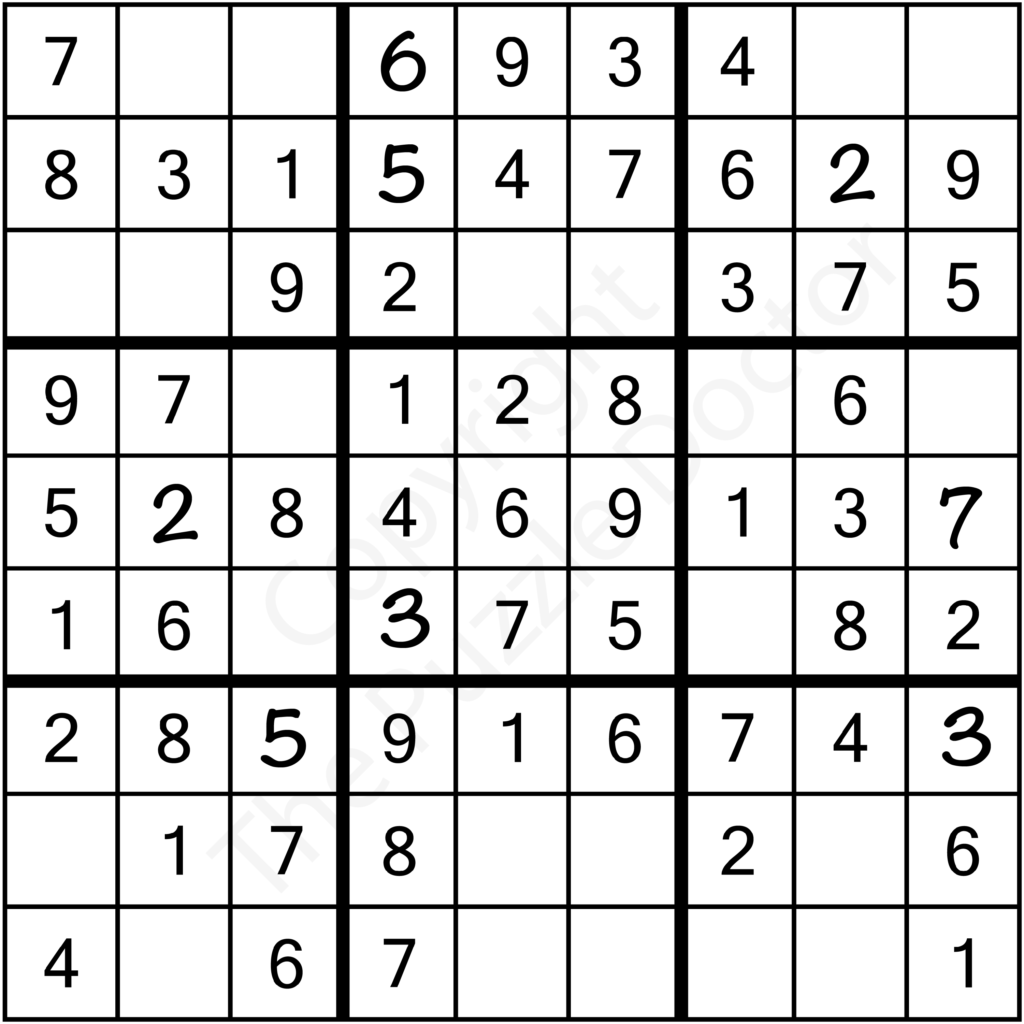
And the process begins again!
Following the same process of looking for rows, columns, or sub-grids that have the fewest numbers to complete, I identify sub-grids 2, 3, 4, and 7 as obvious choices. I choose sub-grid 4. The reason I chose it is because solving it will result in a row and a column having only one remaining candidate to fill in. Essentially, solving it will give me the greatest result.
In sub-grid 4 I see that the number 3 and 4 are missing. Since these are in the same column, I also scan to make sure these numbers are consistent with what is missing from the column. Had I found one of these numbers, it would have indicated an error was made in previous solutions.

Once again using a scanning technique of looking at the associated rows.

I find a number 3 in row F and can eliminate that number as a possibility in column 3 row F.

I fill in the number 4 and then can eliminate that as a possible candidate in row D of the same column and sub-grid.
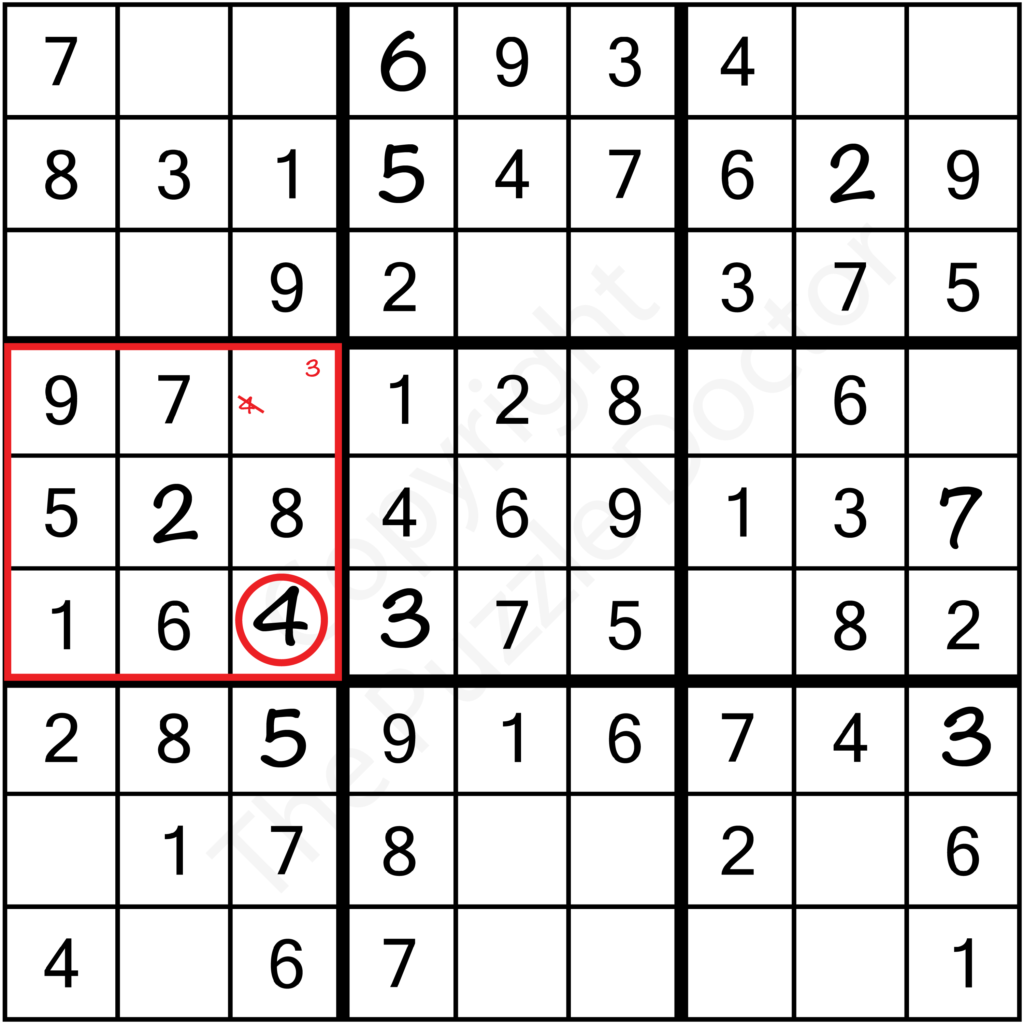
We now have our 2nd sub-grid complete!

Single Candidates found!
I scan the grid again and find a row and a column with only 1 candidate remaining. I determine what these are and fill these in. Making good progress!
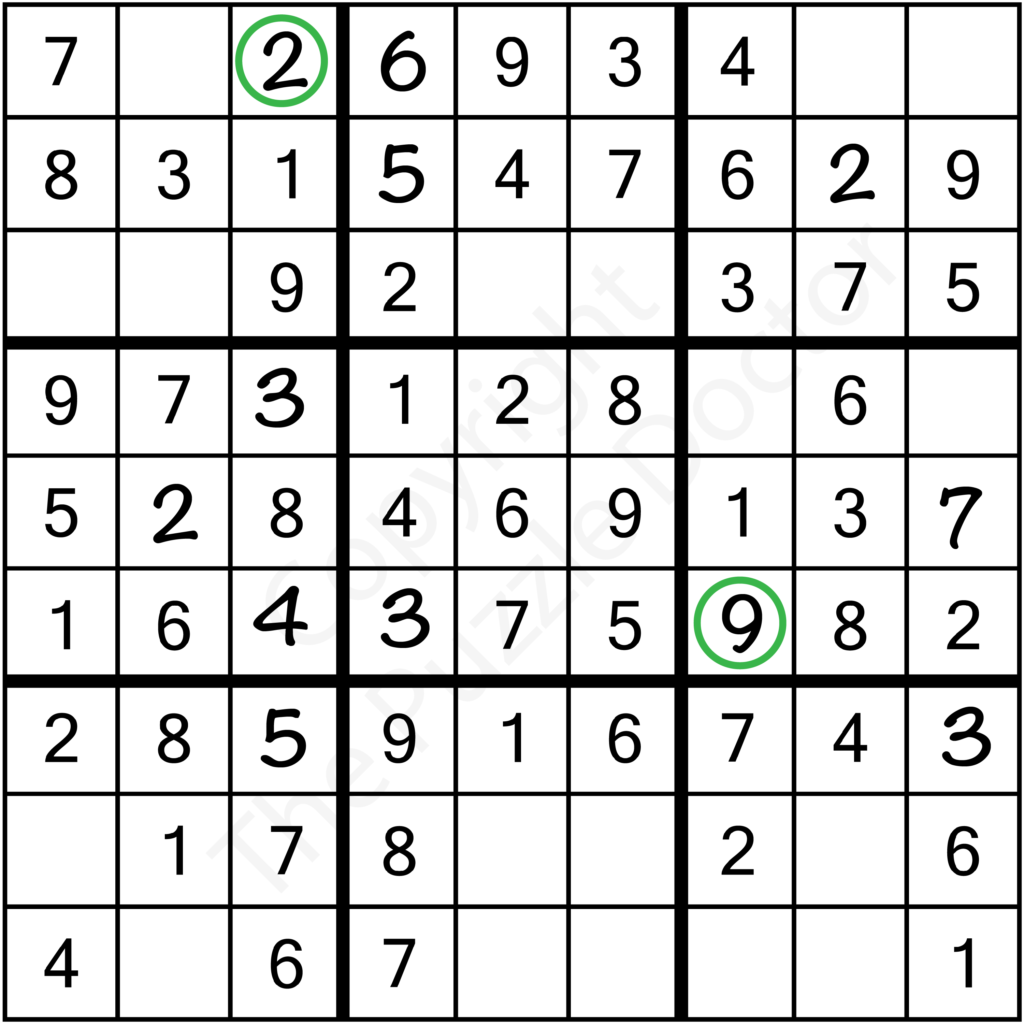
Next, there are a few choices we have about what to solve next. I choose sub-grid 6. The reason I chose this sub-grid is because solving it would result in having the middle third of the Sudoku puzzle complete.
so, I identify what numbers are missing from the sub-grid.
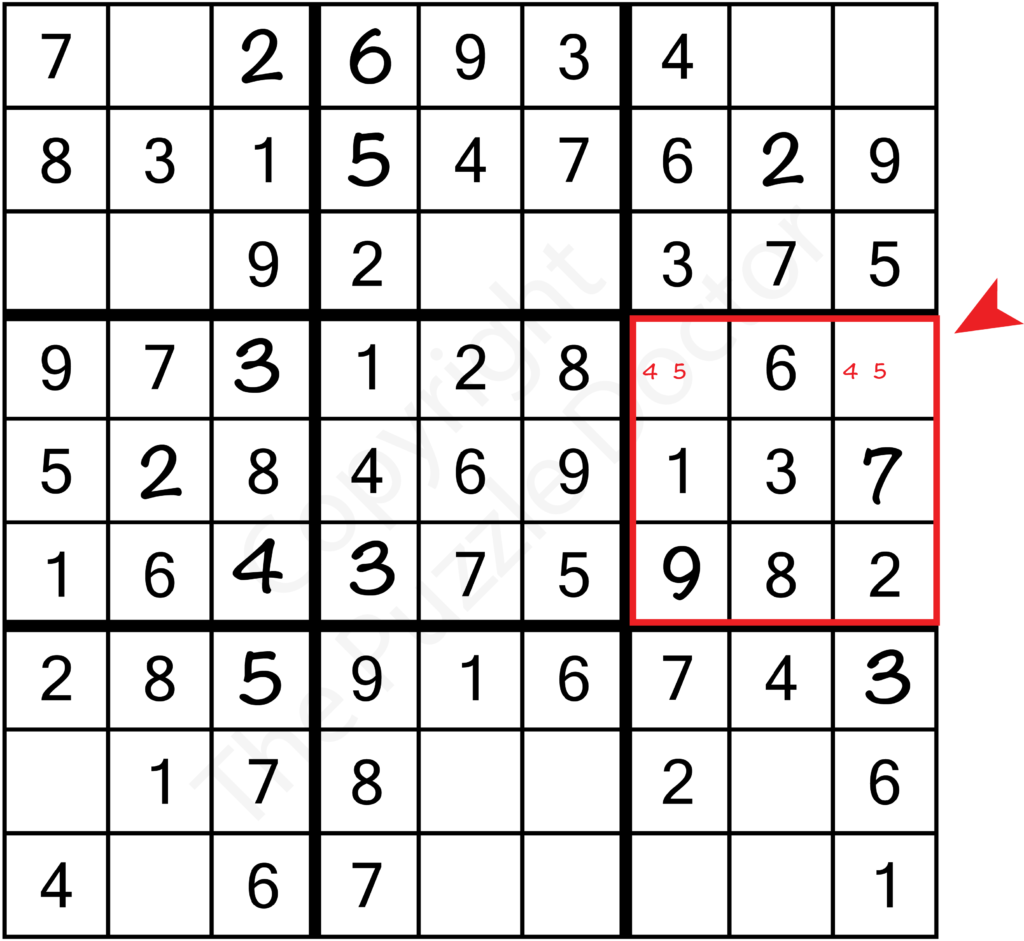
I scan the associated columns to find what numbers to eliminate. I column 7, the number 4 can be eliminated as a candidate. In column 9, the number 5 can be eliminated as a candidate.
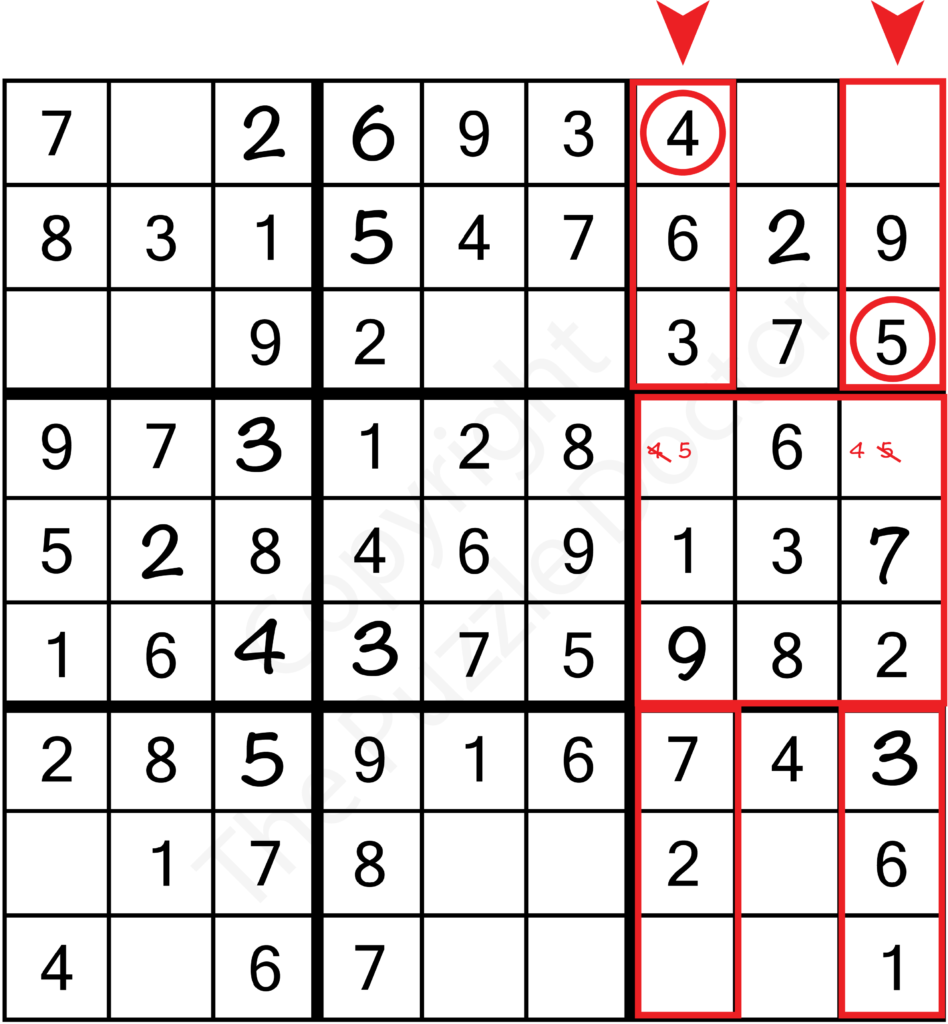
Sub-grid 6 can then be confidently completed!

More Single Candidates!
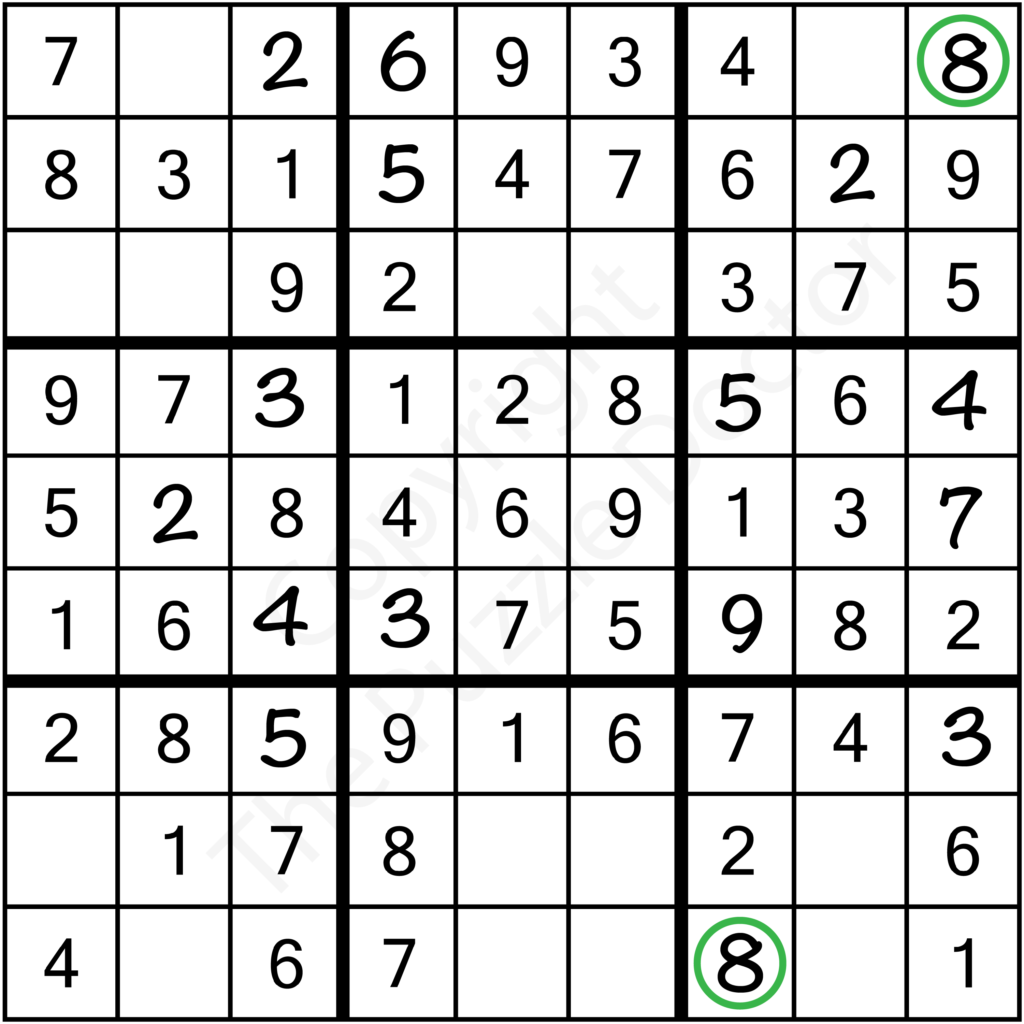
Another sub-grid, sub-grid 3, can then be confidently completed with one remaining number.
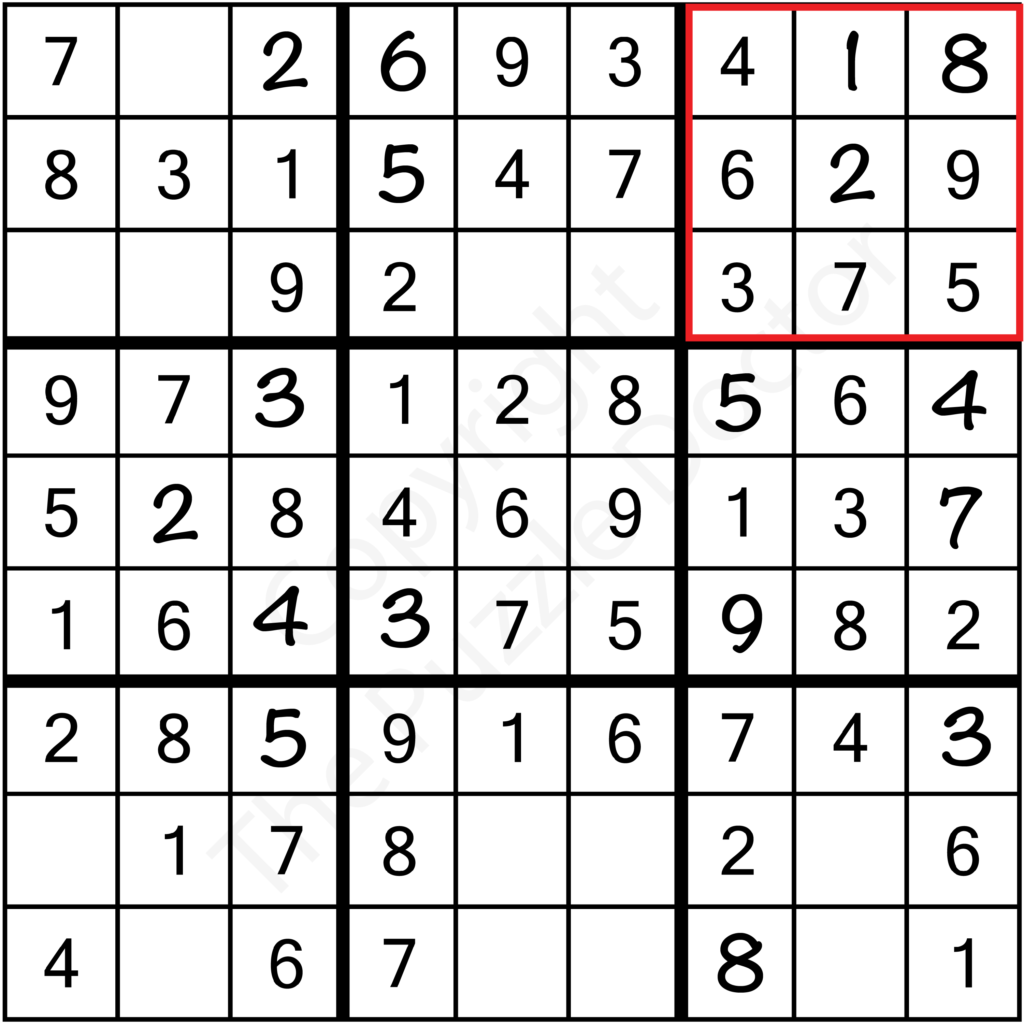
We are left with another obvious choice in row 1. Only the number 5 remains, so we can fill that in. Don’t forget to check the associated columns and sub-grid just in case a mistake was made.
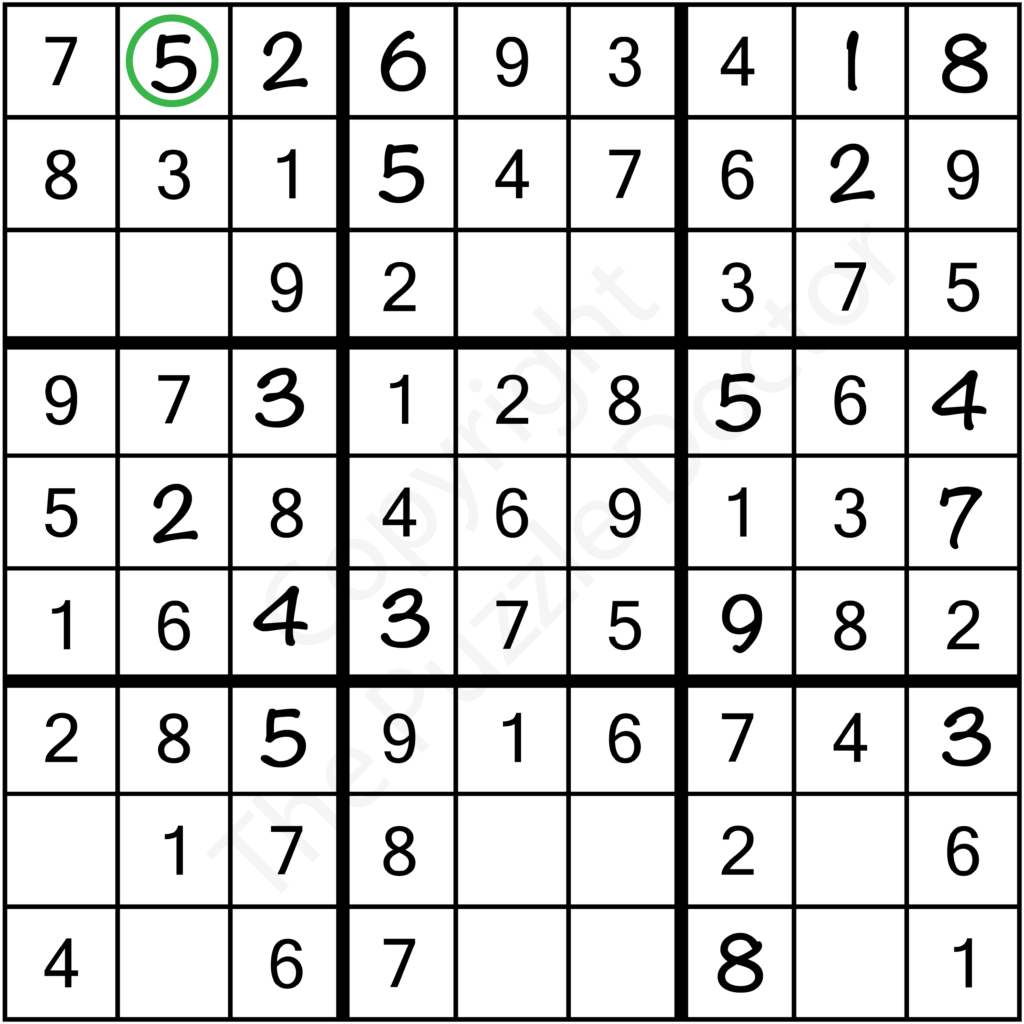
Nearing Completion!
Since the puzzle is near completion and there are a lot of possible choices, I choose sub-grid 1. In this sub-grid, the numbers 4 and 6 are missing. I check that this is consistent with what is missing from the row to ensure I haven’t made a mistake. Using the scanning technique over the associated columns, I note that there is a 4 in column 1 and a 6 in column 2.
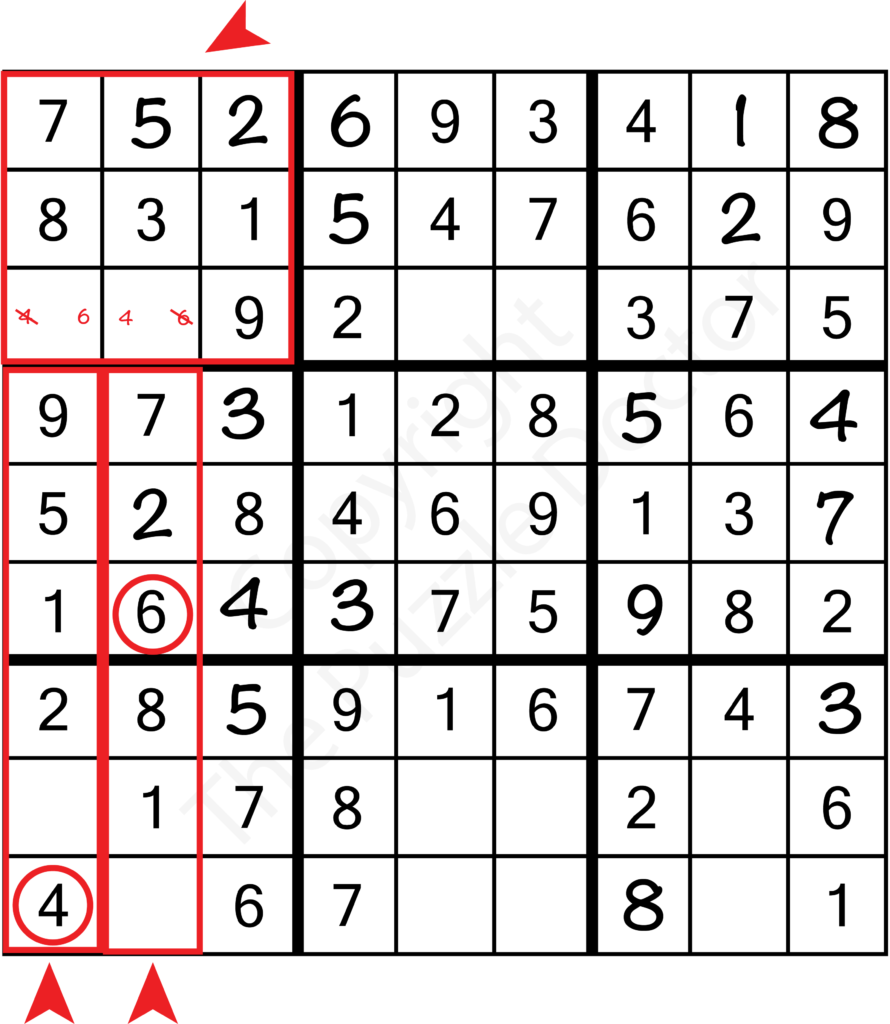
I fill these in and another sub-grid is complete!
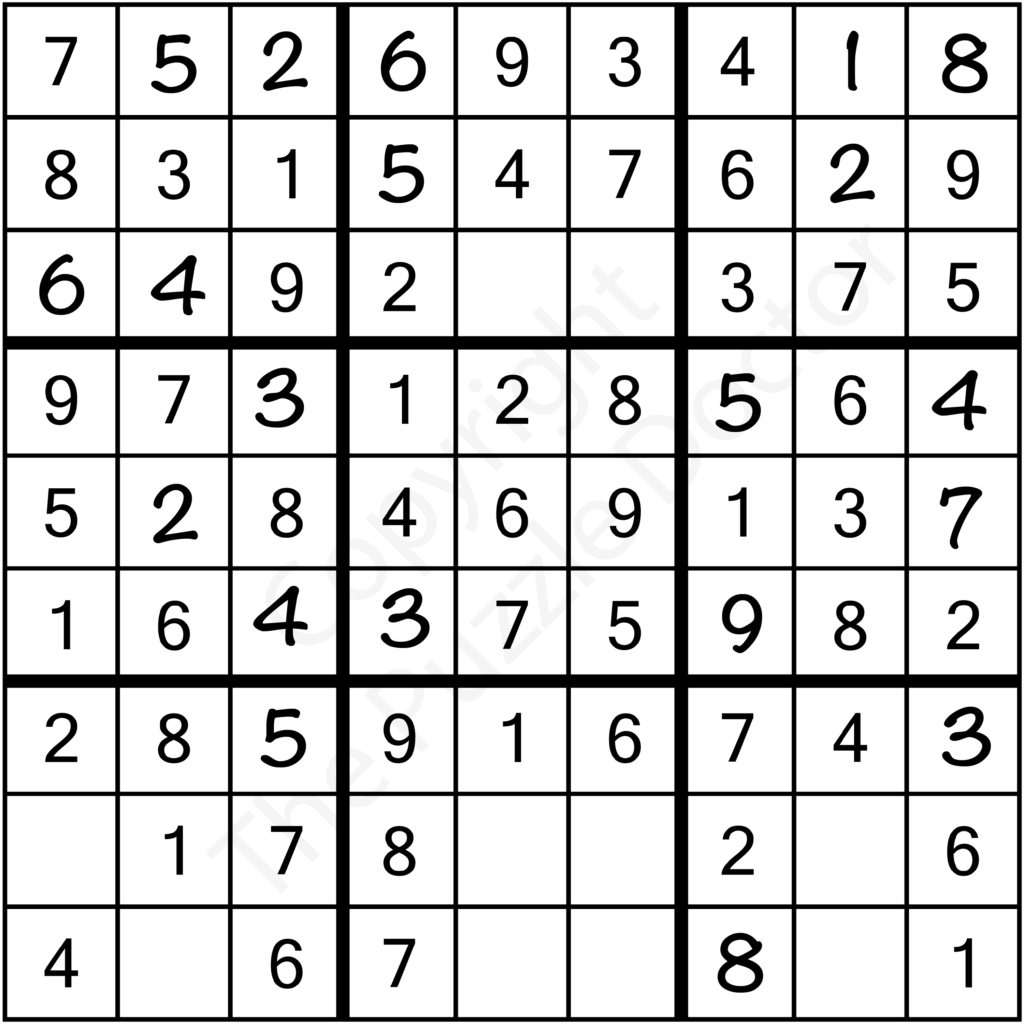
Two single candidate cells open up in sub-grid 7 and we can confidently fill those-in. Don’t forget to always double check by scanning columns and rows just in case a mistake was made.

From here I will illustrate the next steps until completion.


Two thirds complete!

Next steps…


One more sub-grid remains!
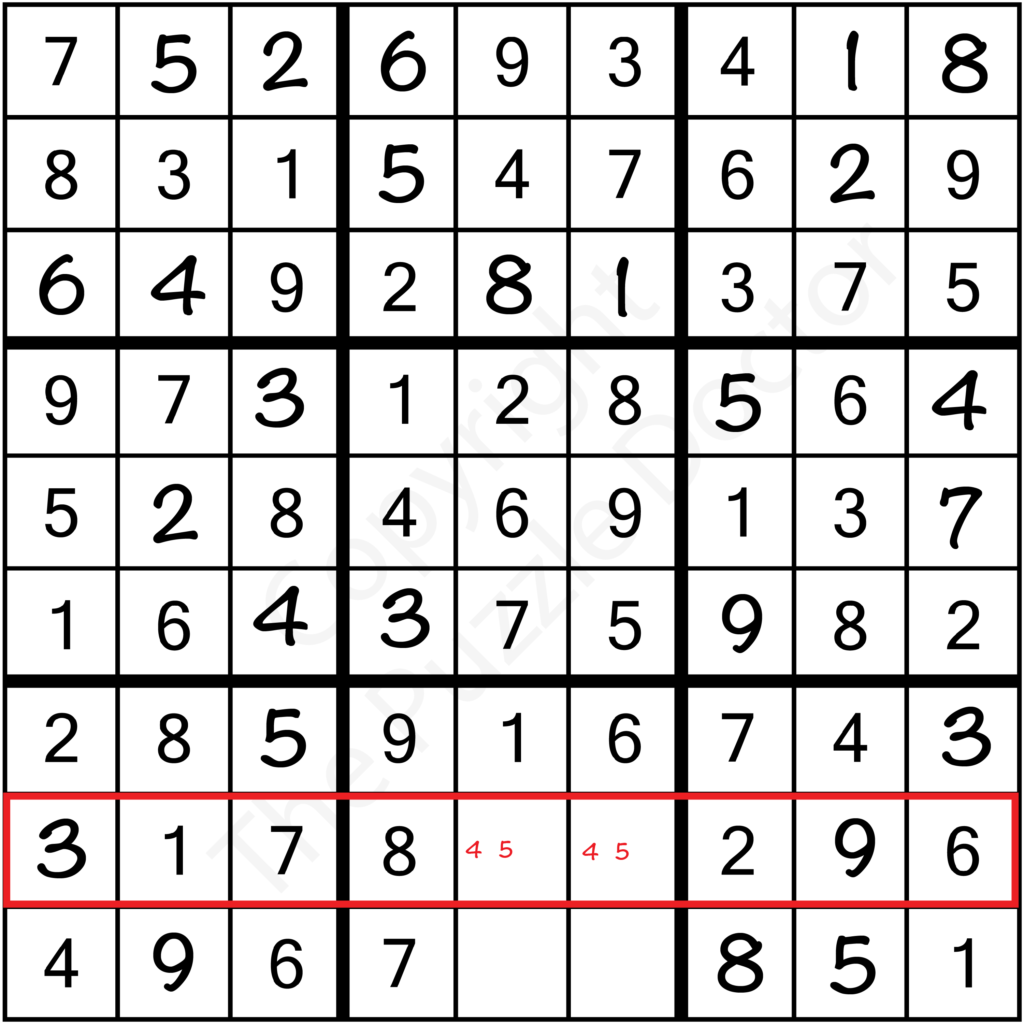

Last row!
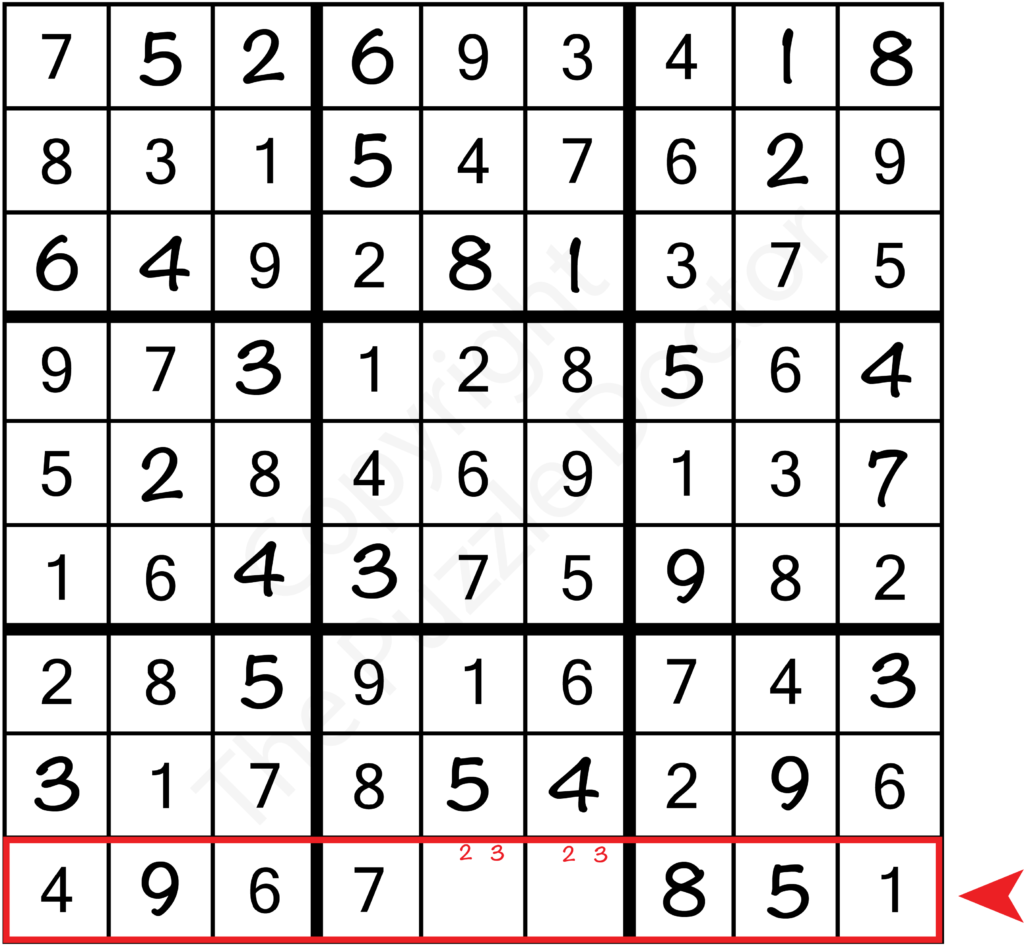

And the Sudoku puzzle is complete!
I hope you enjoyed this very easy Sudoku puzzle walkthrough and learned how to approach your first Sudoku puzzles.
Happy Puzzling!
